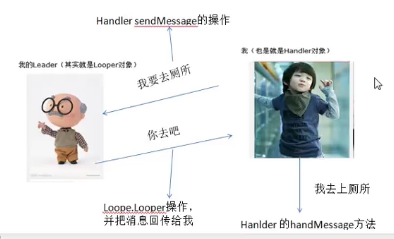帶你深入理解android Handler機制
歡迎轉載請註明來源
說到消息機制,我們一定會想到Handler,由於Android系統規定主線程不能阻塞超過5s,否則會出現”Application Not Responding”。也就是說,你不能在主線程中進行耗時操作(網絡請求,數據庫操作等),只能在子線程中進行。下面先來看一下在子線程中訪問UI會出現什麽情況。
public void click(View v){
new Thread(new Runnable() {
@Override
public void run() {
mTextView.setText("2");
}
}) .start();
}
結果不出意外的報錯:
android.view.ViewRootImpl$CalledFromWrongThreadException: Only the original thread that created a view hierarchy can touch its views.
在ViewRootImpl的checkThread()檢查是否是主線程,如果不是拋異常。

那麽這個時候怎麽解決才能在更新UI呢?其實就是用Handler機制啦!
Handler
先來看一下如何改進代碼,然後詳細分析Handler機制。
public void click(View v){
new Thread(new Runnable() {
@Override
public void run() {
//拿到message對象
Message msg = mHandler.obtainMessage();
msg.arg1 = 2;
mHandler.sendMessage(msg);
}
}) .start();
}
然後在handleMessage中更新UI
private Handler mHandler = new Handler(){
@Override
public void handleMessage(Message msg) {
super.handleMessage(msg);
mTextView.setText(msg.arg1+"");
}
};
這樣就成功了。
僅僅知道怎麽用那肯定是不夠的,我們還需要知道其背後到底幹了什麽。
我們就從 mHandler.sendMessage(msg)開始說起吧。當我們調用sendMessage時候,其實最終調用的是sendMessageAtTime(msg,long)。此方法源碼如下:
public boolean sendMessageAtTime(Message msg, long uptimeMillis) {
MessageQueue queue = mQueue;
if (queue == null) {
RuntimeException e = new RuntimeException(
this + " sendMessageAtTime() called with no mQueue");
Log.w("Looper", e.getMessage(), e);
return false;
}
return enqueueMessage(queue, msg, uptimeMillis);
}
它會調用enqueueMessage()將Message送到MessageQueue中去。那麽MessageQueue是什麽呢?顧名思義是消息隊列,其實在我們創建Handler的時候,它需要與Looper作關聯,Looper類有一個成員變量
MessageQueue mQueue,它就是消息隊列。用來接收Handler發送Message。MessageQueue內部並不是用數組存儲的,而是用鏈表的數據結構,方便添加和刪除。
下面來看一下Looper.looper()源碼,這個方法就是將Message交給Handler.handleMessage去完成的。
public static void loop() {
final Looper me = myLooper();
if (me == null) {
throw new RuntimeException("No Looper; Looper.prepare() wasn't called on this thread.");
}
final MessageQueue queue = me.mQueue;
// Make sure the identity of this thread is that of the local process,
// and keep track of what that identity token actually is.
Binder.clearCallingIdentity();
final long ident = Binder.clearCallingIdentity();
for (;;) {
Message msg = queue.next(); // might block
if (msg == null) {
// No message indicates that the message queue is quitting.
return;
}
// This must be in a local variable, in case a UI event sets the logger
Printer logging = me.mLogging;
if (logging != null) {
logging.println(">>>>> Dispatching to " + msg.target + " " +
msg.callback + ": " + msg.what);
}
msg.target.dispatchMessage(msg);
if (logging != null) {
logging.println("<<<<< Finished to " + msg.target + " " + msg.callback);
}
// Make sure that during the course of dispatching the
// identity of the thread wasn't corrupted.
final long newIdent = Binder.clearCallingIdentity();
if (ident != newIdent) {
Log.wtf(TAG, "Thread identity changed from 0x"
+ Long.toHexString(ident) + " to 0x"
+ Long.toHexString(newIdent) + " while dispatching to "
+ msg.target.getClass().getName() + " "
+ msg.callback + " what=" + msg.what);
}
msg.recycleUnchecked();
}
}
第3,4行:判斷Looper對象是否為空,如果是空,拋出”No Looper; Looper.prepare() wasn’t called on this thread.”異常。換句話說,如果我們在子線程中創建Handler,並調用sendMessage()時候,由於沒有Looper對象,就會拋此異常信息。我們可以通過Looper.prepare()將當前線程轉為Looper線程。該源碼會在下面分析。
主要看 for (;;)那段代碼,它是個死循環,不斷地執行next()方法,如果有新消息,就交給 msg.target.dispatchMessage(msg);這裏msg.target其實就是Handler對象。那麽下面我們看一下Handler.dispatchMessage(msg)到底幹了什麽。
public void dispatchMessage(Message msg) {
if (msg.callback != null) {
handleCallback(msg);
} else {
if (mCallback != null) {
if (mCallback.handleMessage(msg)) {
return;
}
}
handleMessage(msg);
}
}
其實看到這裏就明白了,它調用的就是handleMessage(),所以我們就可以輕松的更新UI界面了!
那麽mCallback.handleMessage(msg)是什麽呢?
接下來我們看一下這個代碼:
private Handler mHandler = new Handler(new Handler.Callback() {
@Override
public boolean handleMessage(Message msg) {
Toast.makeText(getApplicationContext(),"1",Toast.LENGTH_SHORT).show();
return false;
}
}){
@Override
public void handleMessage(Message msg) {
Toast.makeText(getApplicationContext(),"2",Toast.LENGTH_SHORT).show();
}
};
註意:在第5行我return false,結果吐司展現1,展現完之後再展示2.
當return true時,結果吐司只展現1。這樣我們就可以知道,這其實是用來攔截處理消息的。
剛剛提到Looper.prepare()可以將當前線程轉為Looper線程。那看一下Looper.prepare()源碼
private static void prepare(boolean quitAllowed) {
if (sThreadLocal.get() != null) {
throw new RuntimeException("Only one Looper may be created per thread");
}
sThreadLocal.set(new Looper(quitAllowed));
}
通過拋出的那個異常我們可以發現一個Handler只能有一個Looper.而一個Looper內部維護者MessageQueue,當有消息時Looper從MessageQueue中取出消息交給Handler處理。這樣它們之間就建立起關系了。
看一下源碼中的這行代碼 sThreadLocal.set(new Looper(quitAllowed)); 關於ThreadLocal可以看一下我的這篇文章
http://blog.csdn.net/qq_31609983/article/details/52094032
要想到Looper不斷的從MessageQueue中取消息,就必須調用Looper.loop()來不斷取消息.
在子線程中發送消息的完整代碼如下:
public void click(View v){
final Handler handler = new Handler();
new Thread(new Runnable() {
@Override
public void run() {
Looper.prepare();
handler.sendMessage();
Looper.loop();
}
}) .start();
}
註意 Looper.prepare(); handler.sendMessage();這二個方法順序不能變,我們可以看一下Handler構造方法
public Handler(Callback callback, boolean async) {
if (FIND_POTENTIAL_LEAKS) {
final Class<? extends Handler> klass = getClass();
if ((klass.isAnonymousClass() || klass.isMemberClass() || klass.isLocalClass()) &&
(klass.getModifiers() & Modifier.STATIC) == 0) {
Log.w(TAG, "The following Handler class should be static or leaks might occur: " +
klass.getCanonicalName());
}
}
mLooper = Looper.myLooper();
if (mLooper == null) {
throw new RuntimeException(
"Can't create handler inside thread that has not called Looper.prepare()");
}
mQueue = mLooper.mQueue;
mCallback = callback;
mAsynchronous = async;
}
註意這段代碼 mLooper = Looper.myLooper();如果為空,拋異常,該異常意思是必須調用Looper.prepare().這就是說為什麽順序不能改變!
那麽讀者可能會問,我們在主線程創建Handler對象,並沒有調用Looper.prepare()也出什麽問題啊,的確是這樣的,因為ActivityThread 的main()函數裏面 Looper.prepareMainLooper();已經自動幫我們創建好了Looper對象了。看一下源碼:
public static void prepareMainLooper() {
prepare(false);
synchronized (Looper.class) {
if (sMainLooper != null) {
throw new IllegalStateException("The main Looper has already been prepared.");
}
sMainLooper = myLooper();
}
}
註意sMainLooper = myLooper();看一下myLooper()方法:
public static @Nullable Looper myLooper() {
return sThreadLocal.get();
}
講了這麽多,估計對於小白來說有點暈了。哈哈。那麽接下來我盜用一張hyman老師的一張圖分析Handler,MessageQueue,Looper之間的關系吧。。。
 0160904160222603)
0160904160222603)
一天,老板正在和員工開會,員工想上廁所,出於禮貌,對老板說我要去上廁所(sendMessage 到 MessageQueue中) 老板思考了一會兒,回復到”你去吧”(Looper.loop()) , 最後員工去WC了(handleMessage) ,從詢問到最後WC都是員工做的事,這就是它們之間的關系了。。。哈哈哈。
其實Handler發送消息有多種方式
- msg.sendToTarget();
- mHandler.sendMessageAtFrontOfQueue();
- mHandler.sendEmptyMessage()
- mHandler.sendEmptyMessageDelayed()
- mHandler.post()
- mHandler.postDelayed()
雖然有多種方法,但本質都是通過Handler.handleMessage()實現的。
還有幾個這裏就不一一列舉了,有興趣的讀者可以去Android官網吧。。。
聲明
感謝《Android開發藝術探索》,感謝慕課網視頻,感謝郭神。
我來附一下鏈接吧,感興趣的話去看一下吧。。。
視頻:
http://www.imooc.com/learn/267
郭神博客:
http://blog.csdn.net/guolin_blog/article/details/9991569
最後:這是筆者第一次寫分析源碼的文章,(估計也是最後一次了吧。。。哈哈哈。。),寫的不好,比較雜亂,還請讀者多多包涵。寫著寫著就過了24點了,即將迎來大三,希望用這篇文章來為準大三生活開個好頭吧!祝大家生活愉快!
Tags: Android 數據庫操作 original private created
文章來源: